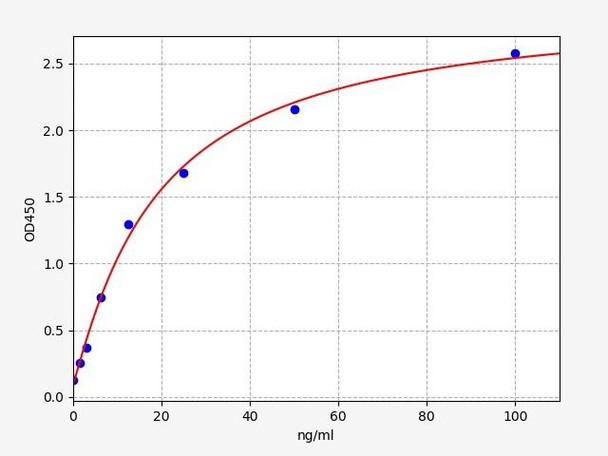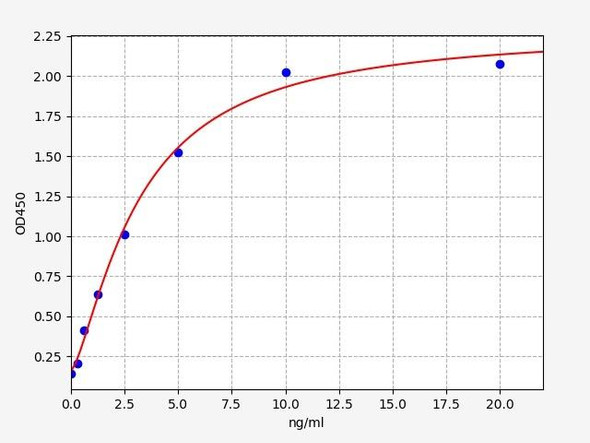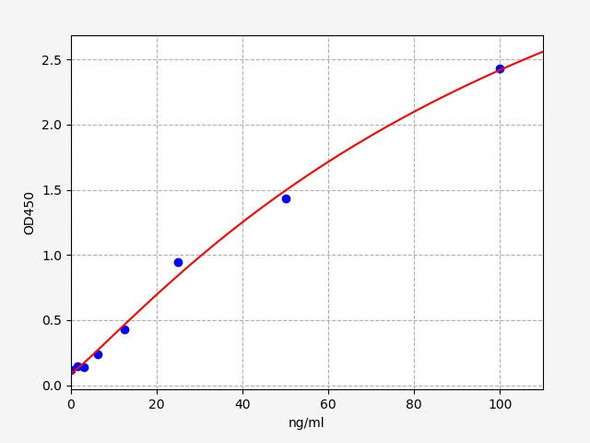Description
Human Complement C4A / C4A ELISA
C4A (Complement C4A (Rodgers Blood Group)) encodes the acidic form of complement factor 4, part of the classical activation pathway. C4A isotype is responsible for effective binding to form amide bonds with immune aggregates or protein antigens. Diseases associated with C4A include Complement Component 4A Deficiency and Blood Group, Chido/Rodgers System. Gene Ontology (GO) annotations related to C4A include endopeptidase inhibitor activity and complement component C1q complex binding. An important paralog of tC4A is C4B.
| Product Name: | Human Complement C4A / C4A ELISA Kit |
| Product Code: | HUFI00464 |
| Size: | 96 Assays |
| Alias: | C4A, C4AD, C4S, CO4, CPAMD2, RG, Complement Component 4a |
| Detection method: | Sandwich ELISA, Double Antibody |
| Application: | This immunoassay kit allows for the in vitro quantitative determination of Human C4A concentrations in serum plasma and other biological fluids. |
| Sensitivity: | 0.938ng/ml |
| Range: | 1.563-100ng/ml |
| Storage: | 4°C for 6 months |
| Note: | For Research Use Only |
| Recovery: | Matrices listed below were spiked with certain level of Human C4A and the recovery rates were calculated by comparing the measured value to the expected amount of Human C4A in samples. | ||||||||||||||||
| |||||||||||||||||
| Linearity: | The linearity of the kit was assayed by testing samples spiked with appropriate concentration of Human C4A and their serial dilutions. The results were demonstrated by the percentage of calculated concentration to the expected. | ||||||||||||||||
| |||||||||||||||||
| CV(%): | Intra-Assay: CV<8% Inter-Assay: CV<10% |
| Component | Quantity | Storage |
| ELISA Microplate (Dismountable) | 8×12 strips | 4°C for 6 months |
| Lyophilized Standard | 2 | 4°C/-20°C |
| Sample/Standard Dilution Buffer | 20ml | 4°C |
| Biotin-labeled Antibody(Concentrated) | 120ul | 4°C (Protect from light) |
| Antibody Dilution Buffer | 10ml | 4°C |
| HRP-Streptavidin Conjugate(SABC) | 120ul | 4°C (Protect from light) |
| SABC Dilution Buffer | 10ml | 4°C |
| TMB Substrate | 10ml | 4°C (Protect from light) |
| Stop Solution | 10ml | 4°C |
| Wash Buffer(25X) | 30ml | 4°C |
| Plate Sealer | 5 | - |
Other materials and equipment required:
- Microplate reader with 450 nm wavelength filter
- Multichannel Pipette, Pipette, microcentrifuge tubes and disposable pipette tips
- Incubator
- Deionized or distilled water
- Absorbent paper
- Buffer resevoir
| Uniprot | P0C0L4 |
| UniProt Protein Function: | C4A: C4 plays a central role in the activation of the classical pathway of the complement system. It is processed by activated C1 which removes from the alpha chain the C4a anaphylatoxin. The remaining alpha chain fragment C4b is the major activation product and is an essential subunit of the C3 convertase (C4b2a) and the C5 convertase (C3bC4b2a) enzymes of the classical complement pathway. Defects in C4A are the cause of complement component 4A deficiency (C4AD). A rare defect of the complement classical pathway associated with the development of autoimmune disorders, mainly systemic lupus with or without associated glomerulonephritis. Defects in C4A are a cause of susceptibility to systemic lupus erythematosus (SLE). A chronic, inflammatory and often febrile multisystemic disorder of connective tissue. It affects principally the skin, joints, kidneys and serosal membranes. It is thought to represent a failure of the regulatory mechanisms of the autoimmune system. Interindividual copy- number variation (CNV) of complement component C4 and associated polymorphisms result in different susceptibilities to SLE. The risk of SLE susceptibility has been shown to be significantly increased among subjects with only two copies of total C4. A high copy number is a protective factor against SLE. |
| UniProt Protein Details: | Protein type:Inhibitor; Secreted, signal peptide; Secreted Chromosomal Location of Human Ortholog: 6p21.3 Cellular Component: extracellular region; extracellular space; plasma membrane Molecular Function:complement component C1q binding; endopeptidase inhibitor activity Biological Process: complement activation; complement activation, classical pathway; inflammatory response; innate immune response; regulation of complement activation Disease: Blood Group, Chido/rodgers System; Complement Component 4a Deficiency |
| NCBI Summary: | This gene encodes the basic form of complement factor 4, part of the classical activation pathway. The protein is expressed as a single chain precursor which is proteolytically cleaved into a trimer of alpha, beta, and gamma chains prior to secretion. The trimer provides a surface for interaction between the antigen-antibody complex and other complement components. The alpha chain may be cleaved to release C4 anaphylatoxin, a mediator of local inflammation. Deficiency of this protein is associated with systemic lupus erythematosus. This gene localizes to the major histocompatibility complex (MHC) class III region on chromosome 6. Varying haplotypes of this gene cluster exist, such that individuals may have 1, 2, or 3 copies of this gene. In addition, this gene exists as a long form and a short form due to the presence or absence of a 6.4 kb endogenous HERV-K retrovirus in intron 9. [provided by RefSeq, Jul 2008] |
| UniProt Code: | P0C0L4 |
| NCBI GenInfo Identifier: | 476007827 |
| NCBI Gene ID: | 721 |
| NCBI Accession: | P0C0L4.2 |
| UniProt Secondary Accession: | P0C0L4,P01028, P78445, Q13160, Q13906, A6H8M8, A6NHJ5 A7E2V2, B0QZR6, B0V2C8, B2RUT6, B7ZVZ6, |
| UniProt Related Accession: | P0C0L5 |
| Molecular Weight: | 187,704 Da |
| NCBI Full Name: | Complement C4-A |
| NCBI Synonym Full Names: | complement component 4B (Chido blood group) |
| NCBI Official Symbol: | C4BÂ Â |
| NCBI Official Synonym Symbols: | CH; C4F; CO4; C4B1; C4B2; C4B3; C4B5; C4BD; C4B12; C4B_2; CPAMD3Â Â |
| NCBI Protein Information: | complement C4-B |
| UniProt Protein Name: | Complement C4-A |
| UniProt Synonym Protein Names: | Acidic complement C4; C3 and PZP-like alpha-2-macroglobulin domain-containing protein 2 |
| Protein Family: | Complement C4 |
| UniProt Gene Name: | C4AÂ Â |
| UniProt Entry Name: | CO4A_HUMAN |
*Note: Protocols are specific to each batch/lot. For the correct instructions please follow the protocol included in your kit.
Before adding to wells, equilibrate the SABC working solution and TMB substrate for at least 30 min at 37°C. When diluting samples and reagents, they must be mixed completely and evenly. It is recommended to plot a standard curve for each test.
| Step | Protocol |
| 1. | Set standard, test sample and control (zero) wells on the pre-coated plate respectively, and then, record their positions. It is recommended to measure each standard and sample in duplicate. Wash plate 2 times before adding standard, sample and control (zero) wells! |
| 2. | Aliquot 0.1ml standard solutions into the standard wells. |
| 3. | Add 0.1 ml of Sample / Standard dilution buffer into the control (zero) well. |
| 4. | Add 0.1 ml of properly diluted sample ( Human serum, plasma, tissue homogenates and other biological fluids.) into test sample wells. |
| 5. | Seal the plate with a cover and incubate at 37 °C for 90 min. |
| 6. | Remove the cover and discard the plate content, clap the plate on the absorbent filter papers or other absorbent material. Do NOT let the wells completely dry at any time. Wash plate X2. |
| 7. | Add 0.1 ml of Biotin- detection antibody working solution into the above wells (standard, test sample & zero wells). Add the solution at the bottom of each well without touching the side wall. |
| 8. | Seal the plate with a cover and incubate at 37°C for 60 min. |
| 9. | Remove the cover, and wash plate 3 times with Wash buffer. Let wash buffer rest in wells for 1 min between each wash. |
| 10. | Add 0.1 ml of SABC working solution into each well, cover the plate and incubate at 37°C for 30 min. |
| 11. | Remove the cover and wash plate 5 times with Wash buffer, and each time let the wash buffer stay in the wells for 1-2 min. |
| 12. | Add 90 µl of TMB substrate into each well, cover the plate and incubate at 37°C in dark within 10-20 min. (Note: This incubation time is for reference use only, the optimal time should be determined by end user.) And the shades of blue can be seen in the first 3-4 wells (with most concentrated standard solutions), the other wells show no obvious color. |
| 13. | Add 50 µl of Stop solution into each well and mix thoroughly. The color changes into yellow immediately. |
| 14. | Read the O.D. absorbance at 450 nm in a microplate reader immediately after adding the stop solution. |
When carrying out an ELISA assay it is important to prepare your samples in order to achieve the best possible results. Below we have a list of procedures for the preparation of samples for different sample types.
| Sample Type | Protocol |
| Serum | If using serum separator tubes, allow samples to clot for 30 minutes at room temperature. Centrifuge for 10 minutes at 1,000x g. Collect the serum fraction and assay promptly or aliquot and store the samples at -80°C. Avoid multiple freeze-thaw cycles. If serum separator tubes are not being used, allow samples to clot overnight at 2-8°C. Centrifuge for 10 minutes at 1,000x g. Remove serum and assay promptly or aliquot and store the samples at -80°C. Avoid multiple freeze-thaw cycles. |
| Plasma | Collect plasma using EDTA or heparin as an anticoagulant. Centrifuge samples at 4°C for 15 mins at 1000 × g within 30 mins of collection. Collect the plasma fraction and assay promptly or aliquot and store the samples at -80°C. Avoid multiple freeze-thaw cycles. Note: Over haemolysed samples are not suitable for use with this kit. |
| Urine & Cerebrospinal Fluid | Collect the urine (mid-stream) in a sterile container, centrifuge for 20 mins at 2000-3000 rpm. Remove supernatant and assay immediately. If any precipitation is detected, repeat the centrifugation step. A similar protocol can be used for cerebrospinal fluid. |
| Cell culture supernatant | Collect the cell culture media by pipette, followed by centrifugation at 4°C for 20 mins at 1500 rpm. Collect the clear supernatant and assay immediately. |
| Cell lysates | Solubilize cells in lysis buffer and allow to sit on ice for 30 minutes. Centrifuge tubes at 14,000 x g for 5 minutes to remove insoluble material. Aliquot the supernatant into a new tube and discard the remaining whole cell extract. Quantify total protein concentration using a total protein assay. Assay immediately or aliquot and store at ≤ -20 °C. |
| Tissue homogenates | The preparation of tissue homogenates will vary depending upon tissue type. Rinse tissue with 1X PBS to remove excess blood & homogenize in 20ml of 1X PBS (including protease inhibitors) and store overnight at ≤ -20°C. Two freeze-thaw cycles are required to break the cell membranes. To further disrupt the cell membranes you can sonicate the samples. Centrifuge homogenates for 5 mins at 5000xg. Remove the supernatant and assay immediately or aliquot and store at -20°C or -80°C. |
| Tissue lysates | Rinse tissue with PBS, cut into 1-2 mm pieces, and homogenize with a tissue homogenizer in PBS. Add an equal volume of RIPA buffer containing protease inhibitors and lyse tissues at room temperature for 30 minutes with gentle agitation. Centrifuge to remove debris. Quantify total protein concentration using a total protein assay. Assay immediately or aliquot and store at ≤ -20 °C. |
| Breast Milk | Collect milk samples and centrifuge at 10,000 x g for 60 min at 4°C. Aliquot the supernatant and assay. For long term use, store samples at -80°C. Minimize freeze/thaw cycles. |
Fill out our quote form below and a dedicated member of staff will get back to you within one working day!






